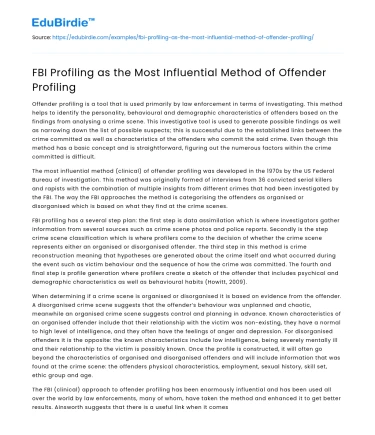Offender profiling is a tool that is used primarily by law enforcement in terms of investigating. This method helps to identify the personality, behavioural and demographic characteristics of offenders based on the findings from analysing a crime scene. This investigative tool is used to generate possible findings as well as narrowing down the list of possible suspects; this is successful due to the established links between the crime committed as well as characteristics of the offenders who commit the said crime. Even though this method has a basic concept and is straightforward, figuring out the numerous factors within the crime committed is difficult.
The most influential method (clinical) of offender profiling was developed in the 1970s by the US Federal Bureau of investigation. This method was originally formed of interviews from 36 convicted serial killers and rapists with the combination of multiple insights from different crimes that had been investigated by the FBI. The way the FBI approaches the method is categorising the offenders as organised or disorganised which is based on what they find at the crime scenes.
Save your time!
We can take care of your essay
- Proper editing and formatting
- Free revision, title page, and bibliography
- Flexible prices and money-back guarantee
FBI profiling has a several step plan: the first step is data assimilation which is where investigators gather information from several sources such as crime scene photos and police reports. Secondly is the step crime scene classification which is where profilers come to the decision of whether the crime scene represents either an organised or disorganised offender. The third step in this method is crime reconstruction meaning that hypotheses are generated about the crime itself and what occurred during the event such as victim behaviour and the sequence of how the crime was committed. The fourth and final step is profile generation where profilers create a sketch of the offender that includes psychical and demographic characteristics as well as behavioural habits (Howitt, 2009).
When determining if a crime scene is organised or disorganised it is based on evidence from the offender. A disorganised crime scene suggests that the offender’s behaviour was unplanned and chaotic, meanwhile an organised crime scene suggests control and planning in advance. Known characteristics of an organised offender include that their relationship with the victim was non-existing, they have a normal to high level of intelligence, and they often have the feelings of anger and depression. For disorganised offenders it is the opposite: the known characteristics include low intelligence, being severely mentally ill and their relationship to the victim is possibly known. Once the profile is constructed, it will often go beyond the characteristics of organised and disorganised offenders and will include information that was found at the crime scene: the offenders physical characteristics, employment, sexual history, skill set, ethic group and age.
The FBI (clinical) approach to offender profiling has been enormously influential and has been used all over the world by law enforcements, many of whom, have taken the method and enhanced it to get better results. Ainsworth suggests that there is a useful link when it comes to predictions about time frames and the next attack as well as how the offences are likely to occur (Ainsworth, 2001). This attempt to organise the data on different types of offenders has played a large role in challenging the stereotypes that are held by investigators, causing them to be misled. An example of this is the findings of Clarke and Morley in which they interviewed 41 convicted rapists who were held responsible for over 800 offences. Their results shocked them as they found that regardless of the stereotype of being a loner, their results showed that they were average men who lived in a normal family circumstance and were often intelligent whilst working in skilled employment (Morley and Clark, 1993).
However, there are some issues with this approach and has had criticism from several quarters. This approach assumes that offenders are either one thing or the other. However, most offenders show both organised and disorganised behaviours whilst committing their crime as well as shifting between the traits for different crimes which limits the usefulness of this method. Canter suggests that the evidence from the crime scene on which the profiles are completed on are most times incomplete, meaning that the judgments which are based on the evidence are normally speculative (Canter, 2000). Another issue is that it is down to the profiler’s opinion: they go on their subjective thoughts meaning that the results can differ from profiler to profiler therefore getting different conclusions from the evidence which is from the same crime scene.






 Stuck on your essay?
Stuck on your essay?

